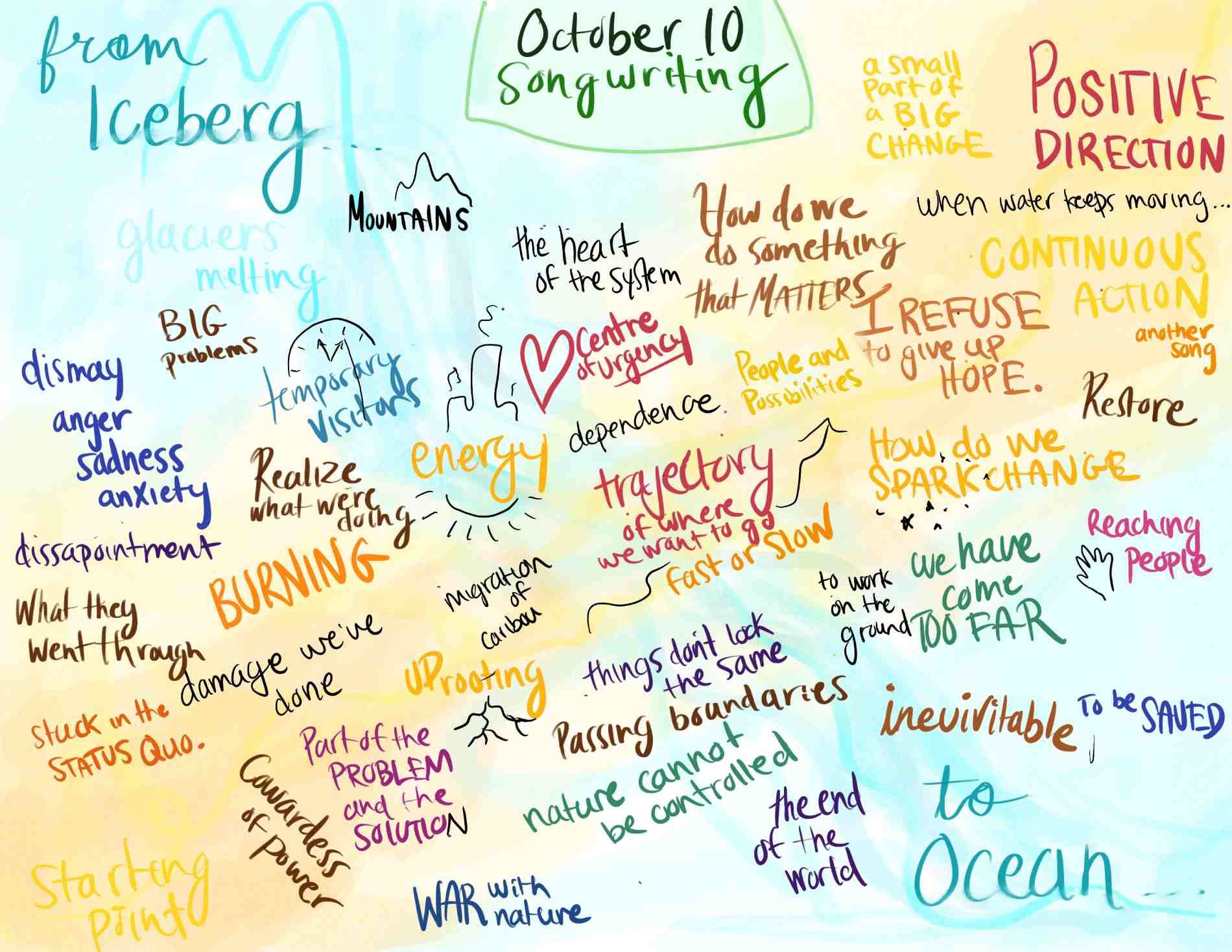Meaningful sustainability action requires linking facts and emotion. At the 2023 Ivey-ARCS PhD Sustainability Academy, music offered that bridge.
Every year, the Ivey-ARCS PhD Sustainability Academy brings together PhD students from around the world. These student “Fellows” experience a week of mentorship, community-building, and inspiration, focused on topics related to business sustainability.
This year, participants also contributed to a song. I was “songwriter in residence” for the 2023 cohort. My role was to capture material shared throughout the week of the PhD Academy and turn it into a song.
I wanted that song to express everything that researchers bring to their work: Their academic insights and also their emotions and passion.
This year’s Academy program focused on climate. Student papers covered topics from lithium mining policy in Latin America to climate adaptation strategies in the California wine industry. Presenters also shared different ways of thinking, and communicating about sustainability: from “ecological knowing” within the body to how humans connect with data when it is shared through sound.
I also organized a session where the Fellows shared their personal reactions and reflections, digging into the feelings that anchor their work.
If you’ve ever wondered what work on business sustainability might sound like set to music, please listen to the performance of our song. And if you’d like to know more about what music brings to sustainability research and how to create a song, read on below.
What Music Brings to Sustainability Work
I’m not a sustainability researcher myself, but I am fortunate enough to work with many of them every day at the Network for Business Sustainability. At NBS, we help communicate the valuable insights from sustainability research in different, more digestible ways – like through short articles, infographics, and social media posts.
But I also have another favourite form of communication: music. For my whole life, singing and playing piano has been one of my most important outlets for expressing emotion. Recently, I’ve been integrating more music in my sustainability work.
Why?
Because I believe that those working in sustainability need to not only communicate data, but also passion and emotion. Doing so can bring others into the cause, by pulling on an audience’s heartstrings alongside their rational mind.
Expressing emotion can also make sustainability work more… well, “sustainable” for the people involved in it. Being immersed in sustainability issues can come with challenging emotions such as disappointment, despair, frustration and guilt. Music can be one outlet to navigate these emotions, helping us stay motivated and healthy.
That’s why I was so excited when PhD Academy co-director Oana Branzei invited me to integrate music in the 2023 PhD Academy program.
Listening for the Passions and Emotions Driving Sustainability Research
The research process doesn’t always leave space for more emotional reflection. That’s the space I wanted to create for the sustainability researchers in the PhD Academy. Here’s how we did it:
Following a moment for individual reflection and mindfulness, we held a collective brainstorming session. I asked everyone to share images, quotes, ideas, or stories related to their sustainability work that resonated with them emotionally. Responses were thoughtful, vulnerable, and poetic. Looking at the Miro notes I took on these reflections, we discussed the emerging themes we heard and saw.
The strongest theme was “movement.” Participants were frustrated that the sustainability transition isn’t happening fast enough. But they also saw glimmers of hope and positive progress – a positive direction.
This connected to a theme around collective action. There’s comfort in the idea that we each play a small part, and that many are involved in sustainability work.
Water trickled throughout the imagery students shared. Students described deep emotional connections to bodies of water in their lives. Academy speakers’ presentations also shared personal relationships with water, including a poem shared by Shelley Price, about a river in her mother’s homeland.
In our discussion, a Fellow shared an Indian proverb that connected water and movement: When water keeps moving, it stays fresh; if it stops, it goes stale. The lesson is that sustained sustainability action is important, even when we face setbacks or feel discouraged.
How These Reflections Became a Song
The discussion provided plenty of “songwriting fuel” for me. Here’s how I used it to write lyrics and create the song’s story arc.
A Visual Representation of Students’ Ideas
Following my conversation with the students, I created this image, which helped me embed the students’ ideas more deeply in my mind and draw more connections between them.
This process helped me unearth many concepts I wanted to honour in the lyrics, including:
-
-
Reality: recognizing our current trajectory of passing planetary boundaries, more frequent catastrophes.
-
-
-
Difficulty: emotions related to our current trajectory.
-
-
-
Passion: the urgency to do something that matters.
-
-
-
Complexity: being part of the problem and solution.
-
-
-
Possibility: an alternative trajectory and positive indicators
-
-
-
Hope: connecting and being part of a movement, with each person a small part of positive system change.
-
These concepts helped me shape the “story arc” of the song:
-
-
Verse 1 &2: the cause for despair
-
-
-
Pre-chorus: current reality and desire to change
-
-
-
Chorus: hope, movement, recognition that change is non-linear
-
-
-
Verse 3 & 4: complexity and tension
-
-
-
Repeat Pre-chorus and chorus
-
-
-
Bridge: hope from finding connection, being small part of a movement
-
-
-
Chorus: end on hope and continuous action
-
Adding Music
The last step was to add music. After creating my visual synthesis late at night, I must have been inspired in my sleep, as I conveniently woke up with a chorus in mind. This was a great lesson for me about how useful it can be to put information in a variety of forms – and to leave time to “sleep on it” in order to think about things differently.
I created chords to fit my chorus idea, and built the rest of the melodies around it. To fill in the verses, I sat at my piano with my summary visual in front of me, experimenting and pulling out phrases for each line, until one “clicked.” Over a few days, with a few more overnight epiphanies, I filled out the whole song. And here it is!
Tap into the Power of Art and Music for Sustainability
I was so grateful to have had the opportunity to hear the perspectives of this year’s inspiring cohort of PhD Academy Fellows. Their ideas and emotions resonated with me and helped me create a song that feels important – but that I may never have created on my own.
One Fellow, Teresa Mannebach (Nova School of Business and Economics) wrote to me afterward about the power of art to express sustainability ideas. , “In listening and seeing, music and art do something ‘weird’ yet wonderful to me,” she wrote. “They make me deeply sad and at the same time highly motivated to keep trying to make a difference through my research. In producing, art specifically helps me to convey what words cannot convey for me – which is the urgency to act and the patience to act right.”
Teresa also shared that she plays ‘our’ song very often, to help focus on what is important. I hope it can do the same for you!




Add a Comment
This site uses User Verification plugin to reduce spam. See how your comment data is processed.This site uses User Verification plugin to reduce spam. See how your comment data is processed.